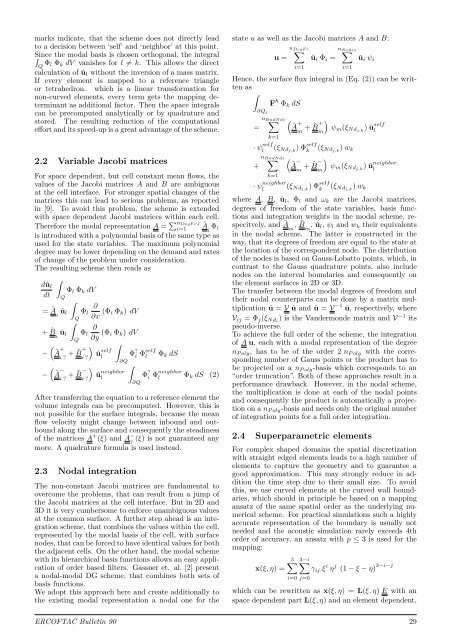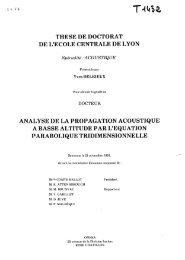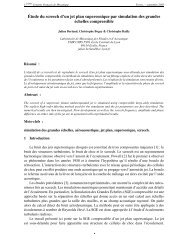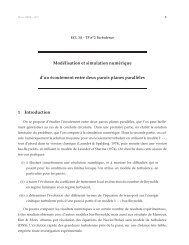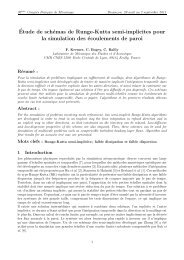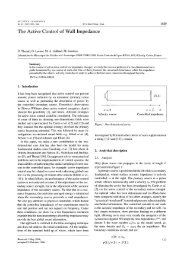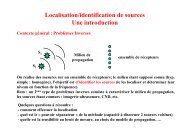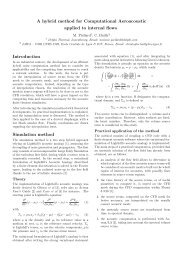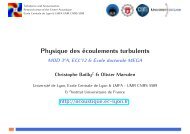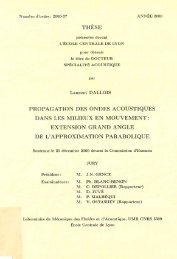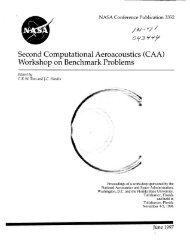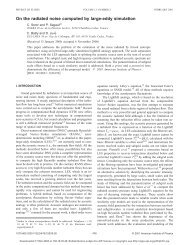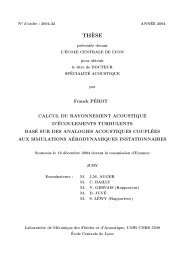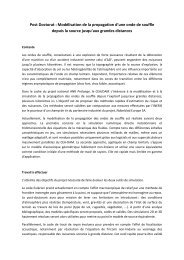ERCOFTAC Bulletin - Centre Acoustique
ERCOFTAC Bulletin - Centre Acoustique
ERCOFTAC Bulletin - Centre Acoustique
You also want an ePaper? Increase the reach of your titles
YUMPU automatically turns print PDFs into web optimized ePapers that Google loves.
marks indicate, that the scheme does not directly lead<br />
to a decision between ‘self’ and ‘neighbor’ at this point.<br />
Since the modal basis is chosen orthogonal, the integral<br />
Q Φl Φk dV vanishes for l = k. This allows the direct<br />
calculation of ûl without the inversion of a mass matrix.<br />
If every element is mapped to a reference triangle<br />
or tetrahedron. which is a linear transformation for<br />
non-curved elements, every term gets the mapping determinant<br />
as additional factor. Then the space integrals<br />
can be precomputed analytically or by quadrature and<br />
stored. The resulting reduction of the computational<br />
effort and its speed-up is a great advantage of the scheme.<br />
2.2 Variable Jacobi matrices<br />
For space dependent, but cell constant mean flows, the<br />
values of the Jacobi matrices A and B are ambiguous<br />
at the cell interface. For stronger spatial changes of the<br />
matrices this can lead to serious problems, as reported<br />
in [9]. To avoid this problem, the scheme is extended<br />
with space dependent Jacobi matrices within each cell.<br />
Therefore the modal representation A = nDegF rJ<br />
i=1 Â Φi<br />
i<br />
is introduced with a polynomial basis of the same type as<br />
used for the state variables. The maximum polynomial<br />
degree may be lower depending on the demand and rates<br />
of change of the problem under consideration.<br />
The resulting scheme then reads as<br />
dûl<br />
dt<br />
<br />
= Â i ûl<br />
+ ˆ <br />
B ûl<br />
i<br />
Φl Φk dV<br />
Q<br />
<br />
Φl<br />
Q<br />
Φl<br />
Q<br />
<br />
+<br />
− Â<br />
i ? + ˆ B +<br />
i ?<br />
<br />
−<br />
− Â<br />
i ? + ˆ B −<br />
i ?<br />
∂<br />
∂x (Φi Φk) dV<br />
∂<br />
∂y (Φi Φk) dV<br />
<br />
<br />
û self<br />
l<br />
∂Q<br />
û neighbor<br />
l<br />
Φ ? i Φ self<br />
l<br />
<br />
∂Q<br />
Φk dS<br />
Φ ? i Φ neighbor<br />
l<br />
Φk dS (2)<br />
After transferring the equation to a reference element the<br />
volume integrals can be precomputed. However, this is<br />
not possible for the surface integrals, because the mean<br />
flow velocity might change between inbound and outbound<br />
along the surface and consequently the steadiness<br />
of the matrices A + (ξ) and A −<br />
? (ξ) is not guaranteed any<br />
more. A quadrature formula is used instead.<br />
2.3 Nodal integration<br />
The non-constant Jacobi matrices are fundamental to<br />
overcome the problems, that can result from a jump of<br />
the Jacobi matrices at the cell interface. But in 2D and<br />
3D it is very cumbersome to enforce unambiguous values<br />
at the common surface. A further step ahead is an integration<br />
scheme, that combines the values within the cell,<br />
represented by the modal basis of the cell, with surface<br />
nodes, that can be forced to have identical values for both<br />
the adjacent cells. On the other hand, the modal scheme<br />
with its hierarchical basis functions allows an easy application<br />
of order based filters. Gassner et. al. [2] present<br />
a nodal-modal DG scheme, that combines both sets of<br />
basis functions.<br />
We adopt this approach here and create additionally to<br />
the existing modal representation a nodal one for the<br />
state u as well as the Jacobi matrices A and B:<br />
u =<br />
nDegF r <br />
i=1<br />
ûi Φi =<br />
nNodes <br />
i=1<br />
ũi ψi<br />
Hence, the surface flux integral in (Eq. (2)) can be written<br />
as <br />
=<br />
∂Qj<br />
F h Φk dS<br />
<br />
nBndNds<br />
k=1<br />
· ψ self<br />
(ξNdj,k l<br />
+<br />
<br />
nBndNds<br />
k=1<br />
<br />
+<br />
Ã<br />
m + ˜ B +<br />
<br />
ψm(ξNdj,k ) ũself<br />
m<br />
l<br />
) Φself<br />
k (ξNdj,k<br />
à −<br />
m + ˜ B −<br />
m<br />
<br />
) wk<br />
ψm(ξNdj,k ) ũneighbor<br />
l<br />
· ψ neighbor<br />
(ξNdj,k l<br />
) Φself(ξNdj,k<br />
k ) wk<br />
where A, B, ûl, Φl and ωk are the Jacobi matrices,<br />
degrees of freedom of the state variables, basis functions<br />
and integration weights in the modal scheme, respecitvely,<br />
and à m , ˜ B m , ũl, ψl and wk their equivalents<br />
in the nodal scheme. The latter is constructed in the<br />
way, that its degrees of freedom are equal to the state at<br />
the location of the correspondent node. The distribution<br />
of the nodes is based on Gauss-Lobatto points, which, in<br />
contrast to the Gauss quadrature points, also include<br />
nodes on the interval boundaries and consequently on<br />
the element surfaces in 2D or 3D.<br />
The transfer between the modal degrees of freedom and<br />
their nodal counterparts can be done by a matrix multiplication<br />
ũ = V û and û = V −1 ũ, respectively, where<br />
Vij = Φj(ξNdi) is the Vandermonde matrix and V −1 its<br />
pseudo-inverse.<br />
To achieve the full order of the scheme, the integration<br />
of A u, each with a modal representation of the degree<br />
nP oly, has to be of the order 2 nP oly with the corresponding<br />
number of Gauss points or the product has to<br />
be projected on a nP oly-basis which corresponds to an<br />
“order truncation”. Both of these approaches result in a<br />
performance drawback. However, in the nodal scheme,<br />
the multiplication is done at each of the nodal points<br />
and consequently the product is automatically a projection<br />
on a nP oly-basis and needs only the original number<br />
of integration points for a full order integration.<br />
2.4 Superparametric elements<br />
For complex shaped domains the spatial discretization<br />
with straight edged elements leads to a high number of<br />
elements to capture the geometry and to guarantee a<br />
good approximation. This may strongly reduce in addition<br />
the time step due to their small size. To avoid<br />
this, we use curved elements at the curved wall boundaries,<br />
which should in principle be based on a mapping<br />
ansatz of the same spatial order as the underlying numerical<br />
scheme. For practical simulations such a highly<br />
accurate representation of the boundary is usually not<br />
needed and the acoustic simulation rarely exceeds 4th<br />
order of accuracy, an ansatz with p ≤ 3 is used for the<br />
mapping:<br />
x(ξ, η) =<br />
3 3−i<br />
i=0 j=0<br />
γij ξ i η j (1 − ξ − η) 3−i−j<br />
which can be rewritten as x(ξ, η) = L(ξ, η) E with an<br />
space dependent part L(ξ, η) and an element dependent,<br />
<strong>ERCOFTAC</strong> <strong>Bulletin</strong> 90 29


